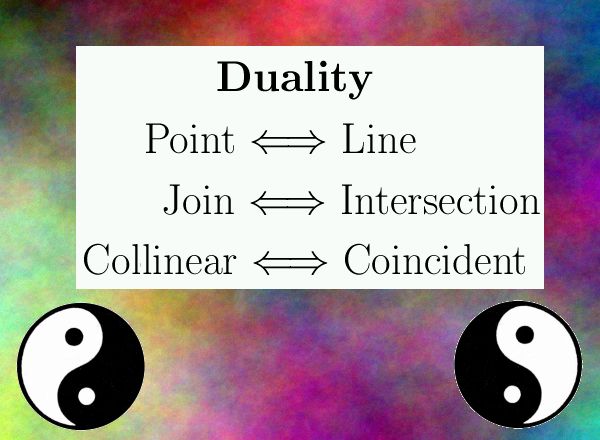Duality in Projective Geometry
In Projective Geometry, there is a dual notion between
points and lines in the plane. That is, the space of all lines in the projective
plane,  ,is a space satisfying all the axioms required of a projective plane. Moreover
the two spaces are exactly equivalent, in that if the term ``line'' is exchanged
with ``point'' and ``collinear'' with ``coincident'' and ``intersection''
with ``join'' etc. then there is no way to tell a difference between the geometry
we started with and the geometry afterwards.
,is a space satisfying all the axioms required of a projective plane. Moreover
the two spaces are exactly equivalent, in that if the term ``line'' is exchanged
with ``point'' and ``collinear'' with ``coincident'' and ``intersection''
with ``join'' etc. then there is no way to tell a difference between the geometry
we started with and the geometry afterwards.

Duality is usually denoted with an  used as a superscript. For example, we defined
used as a superscript. For example, we defined  to be an operation on pairs of collinear triples of points in the plane,that
maps each of these pairs to a line according to Pappus' Theorem. Thus we can
define
to be an operation on pairs of collinear triples of points in the plane,that
maps each of these pairs to a line according to Pappus' Theorem. Thus we can
define  to be its dual. Then
to be its dual. Then  is an operation on pairs of coincident triples of lines in the plane, that
map each of these pairs to a point according to the dual to Pappus' theorem.
is an operation on pairs of coincident triples of lines in the plane, that
map each of these pairs to a point according to the dual to Pappus' theorem.
Let l1, l2,
and l3be three distinct coincident lines and m
1, m2,and m3 be three more distinct
coincident lines incident at a different point. Then we define n
1 to be the unique line containing the two points  and
and  .Similarly we can define
.Similarly we can define  and
and  .The dual to Pappus' Theorem states that these three lines are coincident.
.The dual to Pappus' Theorem states that these three lines are coincident.
The applet below demonstrates the dual to Pappus'
theorem.
You can move the blue and the green points which
in turn move the blue or the green lines that these points are incident on.
The red lines indicate the lines constructed by the dual to Pappus' theorem
and the point represents  .
.
Next Step: Observation Two
|

